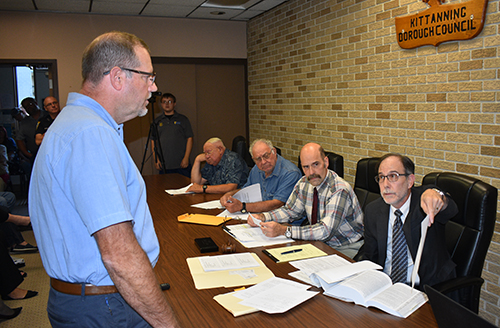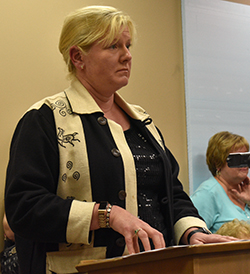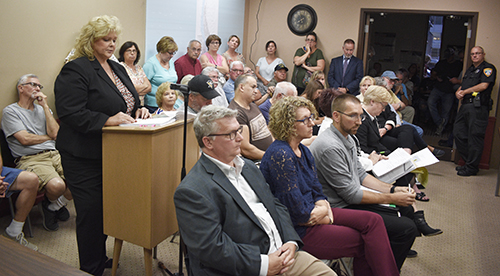
Kittanning Zoning Hearing Board Solicitor James Favero holds up paperwork for Kittanning Borough Zoning Officer Jeff Richardson to identify at last night’s hearing in Council Chambers.
Two hours were not long enough last night to hear all the residents who wanted to speak their mind about the sale of the First Church of God to the Armstrong Indiana Clarion Drug and Alcohol Commission.
The Commission sought a zoning variance to utilize the facility as a recovery center for former alcoholics and those recovering from drug addiction.
The Zoning Hearing Board consisting of Chairman Robert Smith, Joe Close, and Stan Lundsford was guided by their Solicitor James Favero.
Kittanning Borough Zoning Officer Jeff Richardson explained that the property is actually in two different zones – a business zone of B3 and a residential zone of R2. It creates an issue because what is permitted in one zone is not permitted in another.
“Under zoning regulations of R2, a social club is not permitted, but could be allowed by special use, granted by the Zoning Hearing Board,” Richardson said. “In B3, social clubs and business offices are permitted, and could be considered as permitted.” Richardson said the Borough had requested additional information, so it was denied. That denial brought the Commission before the Zoning Hearing Board last night to ask for allowance.
Wexford real estate agent Elaine Shetler-Libent representing the Commission in the purchase of the Woodward Avenue property argued with the Board that the variance was only for the property in the R2 zone and not the B3 zone.
Libent maintained that because the B3 property would be used as a social hall and offices, those are permitted uses and would not need a variance.

Elaine Shetler-Libent representing the Commission in the purchase of the Woodward Avenue property argued with the Board that the variance was only for the property in the R2 zone and not the B3 zone.
“The sanctuary and parsonage on Woodward is R2. We are talking about the sanctuary and parsonage because the B3 is already a permitted use for social hall, kitchen, etc. The B3 building is operating as a cafeteria, offices, and bible school by the church. It can be operated as business office and social club by the commission. A 1976 zoning map on record shows those two buildings are joined by a wall stairway and door. The entrance for the public is in the B3 building. There is a security video camera and gatekeeper to buzz in visitors. That can be similarly used by the commission to allow members and employee access. Only emergency exits will be in R2 property, including ADA emergency exit. There are no plans to grant access to members via the sanctuary or parsonage. No employees or members will be on the residential walkway on Woodward.”
Libent testified that the facility would be used Monday through Friday from 8AM until 8PM, and Saturdays/Sundays from 11AM until 7PM, except for holidays and special events. She said there would be no overnight persons in the facility except the custodial staff.
Chairman Smith accused Libent of trying to state that the uses would be similar to the church, but that a recovery center is not a social club.
“You are trying to make something fit. So far I have heard social club / social hall. The primary use of the building before was a church. It did not make it a social club. To call it a social hall is misleading. For a lot of these things, it sounds like you are cherry picking. It is recovery center. The needs for a recovery center and a church are not the same. Offices in a church are part of a church. Offices in a recovery center are part of a recovery center,” Smith said. “The question is: What is the real use? You mix and match words - Social recovery club - You can’t take a social club and throw recovery in it.”
Smith pressed Commission Executive Director Kami Anderson on the number of people who would be “members” of this recovery center.
“In Armstrong County, we will be lucky to get 50 or 75 at the facility at one time. We will not exceed legal limits on occupancy. Members but wouldn’t all be there at same time,” Anderson said. “They have to remain alcohol and drug free. They have to be involved in recovery support services. Recovery specialists will be there along with case managers, and administrative staff.”
Smith maintained that a recovery center was not provided for in the zoning ordinance, and thus would not be allowed. Anderson disagreed.
“There weren’t recovery centers in 1968. We didn’t have 50 people each year dying. One in three families are now affected due to the opioid problem,” Anderson countered.
Smith argued that the Commission could utilize the Career Link to teach budget management and resume skills.

Armstrong Indiana Clarion Drug & Alcohol Commission Executive Director Kami Anderson tells how they intend to use the church property as a recovery center.
“The YMCA offers a place to work out. Most are unemployed so they would qualify for a free membership. St. Johns offers a 12-Step program. They could go to that. All this money is being spent so they have a place to hang out. (Recovering addicts) have a lot of free time on their hands and now you are going to put them in a residential neighborhood with all that free time,” Smith said.
Anderson disagreed stating that Smith did not understand the stigma associated with addicts in recovery and the comradery that recovery centers provide through a peer approach.
Lundsford brought up the fact that because the Commission serves a three-county area, that other individuals would be coming here from other counties.
“Indiana already has a recovery center,” Anderson responded. “Clarion does not have a large recovery community. We are not limiting it to Armstrong County, but most won’t attend from other counties due to lack of transportation.”
Smith said that all applicants have to demonstrate to the satisfaction of the Zoning Hearing Board that the proposed use will serve primarily the residents of the neighborhood. He questioned the number of local people that would actually be served.
“Most of our people live in Kittanning Borough,” Anderson responded. “Some are from Ford City that walk in our doors for help. They have been here for awhile.”
When asked what the church sanctuary would be used for, Anderson said there are plans for an exercise area, and perhaps a basketball court.
“We have to get engineers to determine the structural area. The parsonage would be used to teach life skills since there is a smaller kitchen in there,” she said.
“It all pertains to the rehabilitation of these drunks,” Lundsford commented. His comment was met with opposition.
The Commission has been operating on Vine Street in Kittanning for the past six years, which Anderson pointed out has never had a problem requiring police intervention.
First Church of God Pastor Nick Wilson said that if the sale of the property was not complete, it would severely limit the church’s future plans that are currently being pursued. He also said that the parsonage was a residence, but is no longer occupied. He said that the upstairs of the B3 building is a classroom wing, while the downstairs is a social hall. He said they occasionally play shuffleboard in the social hall as well.
William Stauffer with the PA Recovery Alliance said he has been in recovery for 33 years.
“I had to avoid everyone in peer groups to stay in recovery. My dad was a steelworker; mom was a church secretary. People say ‘those people’ but these are ‘our’ people. This kind of program is fairly new. I’m not aware of any zoning entity that has recovery center defined.”
Stauffer encouraged the Board to look at the positive affect recovery centers has had on other communities.
However, resident Robin Shafer disagreed.
“We believe there is a need for it. We just don’t want it in this location,” she said. “Our town is saturated with drug and alcohol problems. We don’t need to bring more to a residential area. There is a bar two blocks up the street known for drugs. There is a Laundromat that is well known for drug use. We have a playground that has drug deals going on all the time. This is no place to have recovering people.”
Resident Ron Ruffaner lives just 100 feet from the church. He made an argument that the property should have been zoned in one zone rather than two.
“Boundary lines should be adjusted to include entire property in R2 zone. It should have been done 50 years ago. The building should never hold 2 zoning designations. Since the church cannot be in the B3 zone, it should all be zoned R2,” he said.
Resident Denny Blose said a recovery center would bring down property values. He read from a survey that said communities saw an 8% drop in valuation.
There was standing room only in Council Chambers and others were outside looking in the windows waiting to get into the building. With other residents wanting to speak, the Zoning Hearing Board recessed and will schedule to reconvene within the next 45 days to continue hearing from the public on the matter.
Delay of reaching a decision has Commission attorney Kathleen Gustine concerned.
“The funding has been allocated. There is a certain period of time that funding is available. There is a chance that the longer it goes, we may not have access to these funds,” she said.
The Kittanning Paper and WTYM radio will promote the date and location once it has been set by the Zoning Hearing Board.
